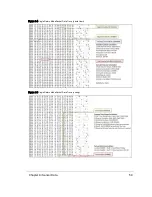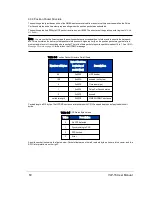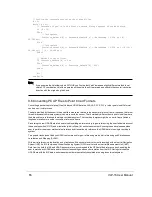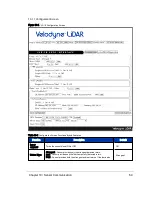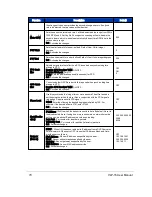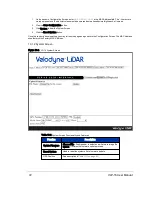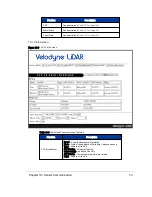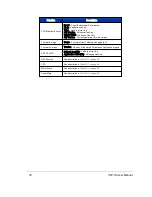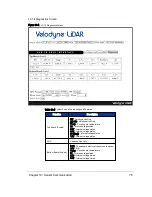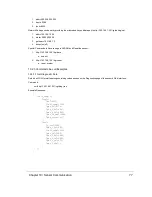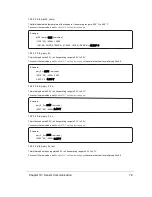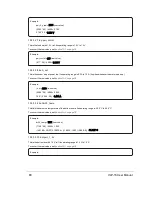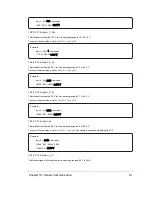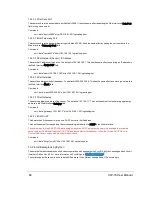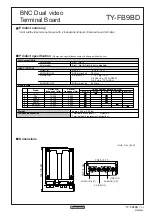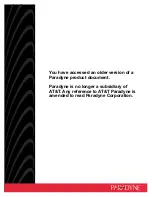
Function
Description
Default
Note:
Take care when turning DHCP ON. Before doing so, ensure a DHCP
server on the network is available to provide the sensor with an IP address. If
you turn DHCP ON and lose contact with the sensor, follow the
DHCP On, Lost Contact With Sensor on page 88
Save Con-
figuration
Saves all current settings to flash memory. Whenever the sensor powers up
or is reset, it is restored to these saved settings. Only the most recent save is
kept.
Download
Snapshot
Clicking this button generates an ASCII text file (name format: <Seri-
alNumber>.hdl) for downloading. It contains a JSON object capturing the
sensor’s state at that moment. The file can be sent to Velodyne
for analysis and to obtain troubleshooting advice.
GPS Position
Displays the last received GPS latitude and longitude.
PPS
Displays the current state of the PPS signal if provided from a GPS. Absent,
Synchronizing, Locked, and Error are the valid states.
Motor State
Indicates if the sensor’s internal motor is spinning: ON/OFF.
RPM — The sensor’s current RPM.
Lock — Indicates the phase lock feature state: ON/OFF.
Phase — Indicates the current phase offset. Only relevant when the phase
lock feature is active. This value is presented in hundredths of a degree.
Laser State
Indicates the current laser array firing status: ON/DISABLED.
Time Synchronization on page 123
for additional information on the PPS and GPS Qualifier functions.
10.1.1.1 MAC Address
The ability to change the sensor's MAC Address was introduced with VLP-16 firmware release 3.0.34.0.
It may be advantageous to do this for asset management in multi-sensor situations where the MAC address is the closest
thing to a hard sensor ID, or as an anti-tracking measure. Bear in mind, however, that multiple sensors with the same MAC
address running on the same network will likely produce undesirable results.
Note: When changing the sensor's MAC Address, the first octet must not be set to an odd value.
00
is ok.
60
is ok.
ff
is
not ok.
As defined by IEEE 802 Standards, the least significant bit of the first octet of a MAC address identifies it as a multicast
address. A sensor bearing a multicast MAC address may cause undesirable network issues.
By extension, never set a MAC Address to the broadcast address (aka. all bits on) or any other group address.
10.1.1.2 Correctly reset MAC Address to Factory MAC Address
If you have changed the sensor's MAC Address to something other than the Factory MAC Address and wish to reset it
back, follow the procedure below.
Chapter 10 • Sensor Communication
71



